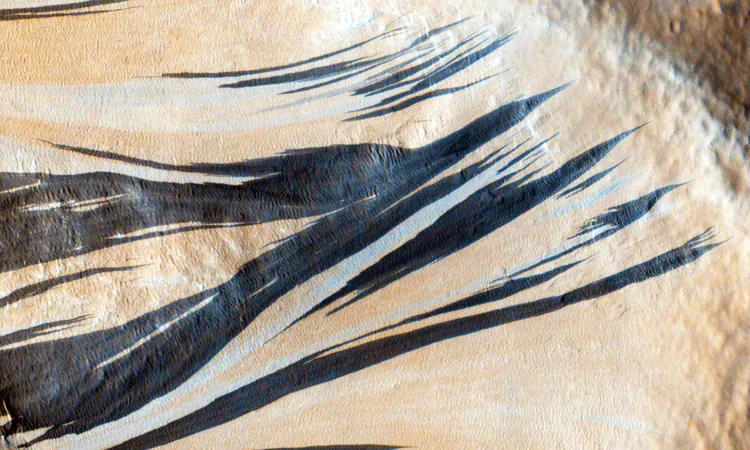
Unraveling Mars' Enigmatic Stripes: Dust, Not Water, Revealed as the Culprit
2025-07-14
Author: Mei
Mysterious Martian Stripes Explained
For decades, scientists have been captivated by the dark, finger-like stripes that descend across the slopes of Mars. These enigmatic features sparked theories suggesting they might be the result of liquid water seeping across the Martian surface. However, a groundbreaking new study now suggests that these stripes emerge from avalanches of dry dust.
The Importance of the Findings
Understanding these Martian stripes is crucial, as they have long fueled speculation about water on the Red Planet, affecting both exploration and planetary protection guidelines. The absence of liquid water means less concern about contamination and shifts focus away from areas that might have once supported life.
Mapping the Martian Stripes
Researchers Valentin Tertius Bickel from the University of Bern and Adomas Valantinas from Brown University utilized advanced deep-learning algorithms to analyze a staggering 86,000 images from Mars. This effort led to the creation of the first comprehensive catalog of over half a million stripes. Surprisingly, these marks occupy less than 0.1% of Mars' surface yet can move significant amounts of dust annually, rivaling entire global dust storms.
The Role of Wind and Impacts
The analysis reveals no connection between these stripes and moisture or ice. Instead, their formation correlates strongly with high wind speeds and recent impacts, indicating that dust is regularly displaced through a potent combination of wind and meteor strikes.
An Opportunity for Exploration
Since the stripes are dry, future Mars rovers can explore these regions without the risk of contaminating potential water sources. Additionally, these dust deposits may serve as natural core samples, providing invaluable information about the planet's recent climatic history without requiring drilling.
A Dusty Climate Cycle
These dust flows play an unexpected role in Mars' atmospheric dynamics, contributing to surface dust levels and influencing seasonal temperature variations. This ongoing dust movement may even impact regional wind patterns in ways previously unconsidered.
Understanding Dust Behavior
Remarkably, the movement of the Martian stripes mimics fluid dynamics, suggesting that even dry dust can flow in smooth waves in Mars' low-gravity environment. This behavior resembles terrestrial phenomena like slow avalanches, challenging our understanding of how dust behaves on another planet.
Lingering Questions and Future Research
Despite these revelations, many questions remain, including why seasonal slope lineae occur primarily in sun-facing southern highlands while the majority of Martian stripes are located in northern lowlands. Future high-resolution imaging missions aim to uncover how quickly these stripes form and whether seismic activity contributes to their creation.
Conclusion: A Dry but Dynamic Planet
The realization that Mars' iconic stripes result from wind and impacts rather than water shifts our perspective on the planet's surface and its potential for life. As researchers continue to investigate these striking features, they reveal a Mars that, while arid, is alive with dynamic processes that shape its landscape.





 Brasil (PT)
Brasil (PT)
 Canada (EN)
Canada (EN)
 Chile (ES)
Chile (ES)
 Česko (CS)
Česko (CS)
 대한민국 (KO)
대한민국 (KO)
 España (ES)
España (ES)
 France (FR)
France (FR)
 Hong Kong (EN)
Hong Kong (EN)
 Italia (IT)
Italia (IT)
 日本 (JA)
日本 (JA)
 Magyarország (HU)
Magyarország (HU)
 Norge (NO)
Norge (NO)
 Polska (PL)
Polska (PL)
 Schweiz (DE)
Schweiz (DE)
 Singapore (EN)
Singapore (EN)
 Sverige (SV)
Sverige (SV)
 Suomi (FI)
Suomi (FI)
 Türkiye (TR)
Türkiye (TR)
 الإمارات العربية المتحدة (AR)
الإمارات العربية المتحدة (AR)